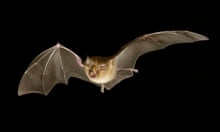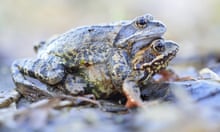Bumblebees are not fast or agile enough flyers to evade an attack from an Asian hornet and an airborne scrap would almost certainly result in victory for the latter.
But University of Exeter scientists have found that when attacked, buff-tailed bumblebees have a dramatic but effective response: simply dropping out of the air “like a brick”, taking the hornet with them.
The bee and hornet hit the ground with such force that the hornet either loses its grip or the bee has the chance to raise its sting and send the attacker scarpering.
Thomas O’Shea-Wheller, of the Environment and Sustainability Institute on Exeter’s Penryn campus in Cornwall, said he and his colleagues were impressed and a little amused when they observed the bumblebees’ technique while doing fieldwork in Galicia, north-west Spain.
“The second the hornet grabs on to or clashes with the bee in the air the bumblebee drops like a brick straight on to the ground,” he said. “Bumblebees even at the best of times don’t appear to the be the most graceful of flyers. If they stop flying they go straight down.
“We really didn’t expect this. Hornets are pretty persistent but that slam-dunk action makes them let go. It bounces them off. Sometimes they do manage to hang on, then the bee will go on to its back and tussle and put its sting up. It makes it too much of an effort for the hornet to stay engaged and achieve anything so they disengage and try to grab the next insect.”
He said buff-tailed bumblebees (Bombus terrestris) nest underground so it may be that they feel more confident heading to the ground when they are attacked. “If you have a predator that’s trying to grab hold, completely bailing out and letting gravity do the rest turns out to be very effective.”
Other insects such as honeybees often suffer a sorry fate when they are attacked by Asian hornets, which hail from east Asia but are increasingly being found in mainland Europe and the UK. “They tussle in the air and the hornet will usually decapitate it, working as quickly as they can, and fly to a branch to process the insect,” said O’Shea-Wheller.
The Exeter team witnessed more than 120 attacks at colony entrances and was stunned to find that bumblebees fought off the hornets every time. But it was not all good news for the bumblebees. The scientists, who have published their research in the journal Communications Biology, found that colonies had reduced growth rates in areas with high numbers of Asian hornets – suggesting the hornets still had a negative impact.
O’Shea-Wheller said. “It’s possible that some external factor is good for Asian hornets, allowing them to thrive, but bad for bumblebees. However, it’s perhaps more likely that the presence of Asian hornets limits the success of bumblebee colonies.
“Although the attacks we witnessed at colony entrances were unsuccessful, bumblebees have been reported in the diet of Asian hornets, and the hornets are known to prey on them elsewhere.”
Sightings of Asian hornets in the UK are at record levels this year, raising fears for native pollinators such as bees.
Five animals that have evolved extraordinary tactics to avoid becoming dinner
Giant cuttlefish
A master of disguise. Rather like chameleons they can change the colour of their skin to blend in with surroundings. But they can go further, possessing muscles they use to change their physical texture so they can go from smooth skinned creatures to looking like a strand of seaweed. Males can also make themselves look like females to avoid confrontation with bigger boys.
Kangaroo rat
The deserts of the south-west US can be a tricky place to navigate for the kangaroo rat, where it is a target for the sidewinder rattlesnake. Their incredible reactions mean they can leap out of the way of snakes within a fraction of a second. They also have karate-style kicks in their locker if the snake gets too close, enabling them to leap and flick it away before it can strike.
Pufferfish
Making yourself seem bigger than an aggressor is a common tactic across the animal kingdom, including in humans. Pufferfish or blowfish can fill their stomachs with large amounts of water, inflating themselves to several times their normal size. Some pufferfish species also have spines on their skin to ward off predators and most contain a toxic substance that makes them foul tasting and potentially deadly.
Regal horned lizard
Another desert dweller, this lizard does not move swiftly so needs another method of self-defence. One of its tactics is to shoot blood from its eyes, which can ward off hungry coyotes. It has an impressive range of about 1 metre (3ft). It can also change colour and suck in air to inflate itself, a little like the pufferfish.
Opossum
The eastern hognose snake, pygmy grasshopper and lemon shark are among the animals that play dead – the scientific term is thanatosis, or tonic immobility – to trick predators. Opossums do it in style, throwing themselves on to their backs, baring their teeth, drooling saliva and excreting a foul-smelling liquid from their anal glands.









